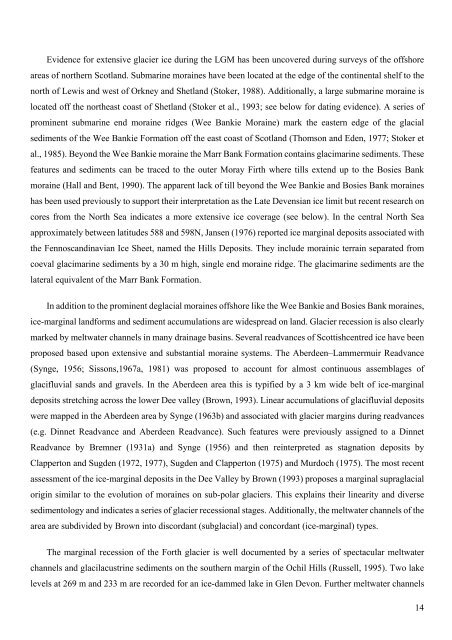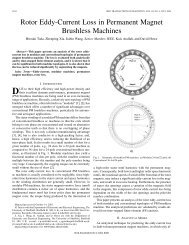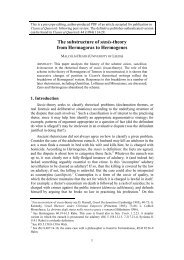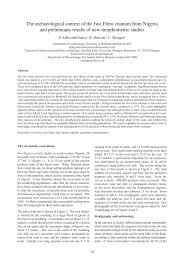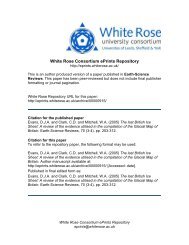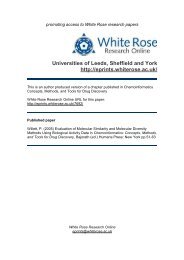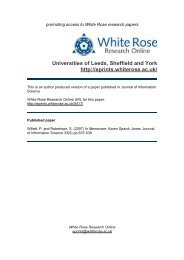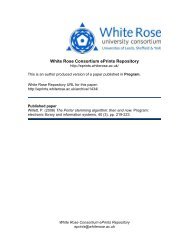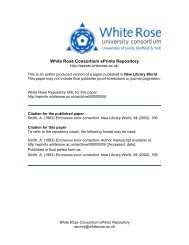The last British Ice Sheet: A review of the evidence utilised in the ...
The last British Ice Sheet: A review of the evidence utilised in the ...
The last British Ice Sheet: A review of the evidence utilised in the ...
You also want an ePaper? Increase the reach of your titles
YUMPU automatically turns print PDFs into web optimized ePapers that Google loves.
Evidence for extensive glacier ice dur<strong>in</strong>g <strong>the</strong> LGM has been uncovered dur<strong>in</strong>g surveys <strong>of</strong> <strong>the</strong> <strong>of</strong>fshore<br />
areas <strong>of</strong> nor<strong>the</strong>rn Scotland. Submar<strong>in</strong>e mora<strong>in</strong>es have been located at <strong>the</strong> edge <strong>of</strong> <strong>the</strong> cont<strong>in</strong>ental shelf to <strong>the</strong><br />
north <strong>of</strong> Lewis and west <strong>of</strong> Orkney and Shetland (Stoker, 1988). Additionally, a large submar<strong>in</strong>e mora<strong>in</strong>e is<br />
located <strong>of</strong>f <strong>the</strong> nor<strong>the</strong>ast coast <strong>of</strong> Shetland (Stoker et al., 1993; see below for dat<strong>in</strong>g <strong>evidence</strong>). A series <strong>of</strong><br />
prom<strong>in</strong>ent submar<strong>in</strong>e end mora<strong>in</strong>e ridges (Wee Bankie Mora<strong>in</strong>e) mark <strong>the</strong> eastern edge <strong>of</strong> <strong>the</strong> glacial<br />
sediments <strong>of</strong> <strong>the</strong> Wee Bankie Formation <strong>of</strong>f <strong>the</strong> east coast <strong>of</strong> Scotland (Thomson and Eden, 1977; Stoker et<br />
al., 1985). Beyond <strong>the</strong> Wee Bankie mora<strong>in</strong>e <strong>the</strong> Marr Bank Formation conta<strong>in</strong>s glacimar<strong>in</strong>e sediments. <strong>The</strong>se<br />
features and sediments can be traced to <strong>the</strong> outer Moray Firth where tills extend up to <strong>the</strong> Bosies Bank<br />
mora<strong>in</strong>e (Hall and Bent, 1990). <strong>The</strong> apparent lack <strong>of</strong> till beyond <strong>the</strong> Wee Bankie and Bosies Bank mora<strong>in</strong>es<br />
has been used previously to support <strong>the</strong>ir <strong>in</strong>terpretation as <strong>the</strong> Late Devensian ice limit but recent research on<br />
cores from <strong>the</strong> North Sea <strong>in</strong>dicates a more extensive ice coverage (see below). In <strong>the</strong> central North Sea<br />
approximately between latitudes 588 and 598N, Jansen (1976) reported ice marg<strong>in</strong>al deposits associated with<br />
<strong>the</strong> Fennoscand<strong>in</strong>avian <strong>Ice</strong> <strong>Sheet</strong>, named <strong>the</strong> Hills Deposits. <strong>The</strong>y <strong>in</strong>clude mora<strong>in</strong>ic terra<strong>in</strong> separated from<br />
coeval glacimar<strong>in</strong>e sediments by a 30 m high, s<strong>in</strong>gle end mora<strong>in</strong>e ridge. <strong>The</strong> glacimar<strong>in</strong>e sediments are <strong>the</strong><br />
lateral equivalent <strong>of</strong> <strong>the</strong> Marr Bank Formation.<br />
In addition to <strong>the</strong> prom<strong>in</strong>ent deglacial mora<strong>in</strong>es <strong>of</strong>fshore like <strong>the</strong> Wee Bankie and Bosies Bank mora<strong>in</strong>es,<br />
ice-marg<strong>in</strong>al landforms and sediment accumulations are widespread on land. Glacier recession is also clearly<br />
marked by meltwater channels <strong>in</strong> many dra<strong>in</strong>age bas<strong>in</strong>s. Several readvances <strong>of</strong> Scottishcentred ice have been<br />
proposed based upon extensive and substantial mora<strong>in</strong>e systems. <strong>The</strong> Aberdeen–Lammermuir Readvance<br />
(Synge, 1956; Sissons,1967a, 1981) was proposed to account for almost cont<strong>in</strong>uous assemblages <strong>of</strong><br />
glacifluvial sands and gravels. In <strong>the</strong> Aberdeen area this is typified by a 3 km wide belt <strong>of</strong> ice-marg<strong>in</strong>al<br />
deposits stretch<strong>in</strong>g across <strong>the</strong> lower Dee valley (Brown, 1993). L<strong>in</strong>ear accumulations <strong>of</strong> glacifluvial deposits<br />
were mapped <strong>in</strong> <strong>the</strong> Aberdeen area by Synge (1963b) and associated with glacier marg<strong>in</strong>s dur<strong>in</strong>g readvances<br />
(e.g. D<strong>in</strong>net Readvance and Aberdeen Readvance). Such features were previously assigned to a D<strong>in</strong>net<br />
Readvance by Bremner (1931a) and Synge (1956) and <strong>the</strong>n re<strong>in</strong>terpreted as stagnation deposits by<br />
Clapperton and Sugden (1972, 1977), Sugden and Clapperton (1975) and Murdoch (1975). <strong>The</strong> most recent<br />
assessment <strong>of</strong> <strong>the</strong> ice-marg<strong>in</strong>al deposits <strong>in</strong> <strong>the</strong> Dee Valley by Brown (1993) proposes a marg<strong>in</strong>al supraglacial<br />
orig<strong>in</strong> similar to <strong>the</strong> evolution <strong>of</strong> mora<strong>in</strong>es on sub-polar glaciers. This expla<strong>in</strong>s <strong>the</strong>ir l<strong>in</strong>earity and diverse<br />
sedimentology and <strong>in</strong>dicates a series <strong>of</strong> glacier recessional stages. Additionally, <strong>the</strong> meltwater channels <strong>of</strong> <strong>the</strong><br />
area are subdivided by Brown <strong>in</strong>to discordant (subglacial) and concordant (ice-marg<strong>in</strong>al) types.<br />
<strong>The</strong> marg<strong>in</strong>al recession <strong>of</strong> <strong>the</strong> Forth glacier is well documented by a series <strong>of</strong> spectacular meltwater<br />
channels and glacilacustr<strong>in</strong>e sediments on <strong>the</strong> sou<strong>the</strong>rn marg<strong>in</strong> <strong>of</strong> <strong>the</strong> Ochil Hills (Russell, 1995). Two lake<br />
levels at 269 m and 233 m are recorded for an ice-dammed lake <strong>in</strong> Glen Devon. Fur<strong>the</strong>r meltwater channels<br />
14


